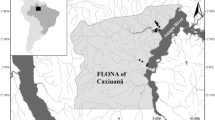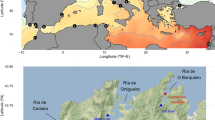Abstract
The influence of size (as biomass), morphology and depth on reproductive patterns was examined in populations ofChondrus crispus in the sublittoral zone of Prince Edward Island, Canada. Fronds of ≥ 10 mg wet wt were considered, and a minimum biomass could not be related to reproduction. However, as frond biomass increased, the frequency of reproductive structures also increased. Reproductive maturity was related to the number of dichotomies. Fronds with less than two dichotomies were only occasionally reproductive, while those with two or more dichotomies could bear sori. Depth in the Prince Edward Island environment had no apparent influence on reproductive maturity, and there was no apparent relationship between depth and the vertical distribution of cystocarpic or tetrasporic fronds.
Similar content being viewed by others
References
Bhattacharya D (1985) The demography ofChondrus crispus Stackhouse. J. exp. mar. Biol. Ecol. 91: 217–231.
Chapman ARO (1986) Age versus stage: analysis of age- and size-specific mortality and reproduction in a population ofLaminaria longicruris Pyl. J. exp. mar. Biol. Ecol. 97: 113–122.
Chopin T, Pringle JD, Semple RE (1988) Reproductive capacity of dragraked and non-dragraked Irish moss (Chondrus crispus Stackhouse) beds in the southern Gulf of St. Lawrence. Can. J. Fish. aquat. Sci. 45: 758–766.
Craigie JS, Pringle JD (1978) Spatial distribution of tetrasporophytes and gametophytes in four Maritime populations ofChondrus crispus. Can. J. Bot. 56: 2910–2914.
DeWreede RE, Klinger T (1988). Reproductive strategies in algae. In: Lovett Doust J, Lovett Doust L (eds), Plant Reproductive Ecology: Patterns and Strategies. Oxford University Press, 267–268.
Hannach G, Santelices B (1985) Ecological differences between the isomorphic reproductive phases of two species ofIridaea (Rhodophyta, Gigartinales). Mar. Ecol. Progr. Set. 22: 291–303.
Hansen JE, Doyle WT (1976). Ecology and natural history ofIridaea cordata (Rhodophyta: Gigartinaceae): Population structure. J. Phycol. 12: 273–278.
Lazo ML (1987) Population structure ofChondrus crispus Stackhouse along the coast of Prince Edward Island. Thesis, Dalhousie University, Halifax.
Lazo ML, Greenwell M, McLachlan J (1989) Population structure ofChondrus crispus Stackhouse (Gigartinales, Rhodophyta) along the coast of Prince Edward Island, Canada: Distribution of gametophytic and sporophytic fronds. J. exp. mar. Biol. Ecol. 126: 45–58.
McCandless EL (1981) Biology and control of carrageenan structure: effects conferred by the phase of the life cycle of the carrageenophyte. Proc. int. seaweed Symp. 8: 1–18.
McLachlan JL, Lewis NI, Lazo ML (1988) Biological considerations ofChondrus crispus Stackhouse (Rhodophyta, Gigartinaceae) in the southern Gulf of St. Lawrence. Gayana, Bot 45: 29–54.
McLachlan JL, Quinn J, MacDougall C (1989) The structure of the plant ofChondrus crispus Stackhouse (Irish moss). J. appl. Phycol. 1: 311–317.
Mann KH (1972) Ecological energetics of the seaweed zone in a marine bay on the Atlantic coast of Canada. I. Zonation and biomass of Seaweeds. Mar. Biol. 12: 1–10.
Mathieson AC, Burns R (1975) Ecological studies of economic red algae. V. Growth and reproduction of natural and harvested populations ofChondrus crispus Stackhouse in New Hampshire. J. exp. mar. Biol. Ecol. 17: 137–156.
Norall TL, Mathieson AC, Killar JA (1981) Reproductive ecology of four subtidal red algae. J. Exp. mar. biol. Ecol. 54: 119–136.
Novaczek I (1984) Development and phenology ofEcklonia radiata (C. Ag.)J. Ag. (Laminariales) at two depths in Goat Island, New Zealand. Mar. Biol. 81: 189–197.
Pringle JD, Semple R (1988). Impact of harvesting on Irish moss (Chondrus crispus Stackhouse) frond size-class structure. Can. J. Fish. aquat. Sci. 45: 767–773.
Roland WG. (1984) Resource management biology for the edible kelpCymathere triplicata. Can. J. Fish. aquat. Sci. 41: 271–277.
Schiel DR (1985). Growth, survival and reproduction of two species of marine algae at different densities in natural stands. J. Ecol. 73: 199–217.
Stanley N (1987) Function, properties and uses of carrageenans. In: McHugh DJ (ed.), Production and Utilization of Products from Commercial Seaweeds. FAO Fish. Tech. Paper 288, Rome, 116–146.
Werner PA (1975) Predictions of fate from rosette size in teasel (Dipsacus fullonum L.). Oecologia 20: 197–201.
Werner PA, Caswell H (1977) Population growth rates and age- versus stage-distribution models for teasel (Dipsacus sylvestris Huds.) Ecology 58: 1103–1111.
White J (1981). The allometric interpretation of the self-thinning rule. J. theor. Biol. 89: 475–500.
Author information
Authors and Affiliations
Rights and permissions
About this article
Cite this article
Lazo, M.L., McLachlan, J.L. Reproduction ofChondrus crispus Stackhouse (Rhodophyta, Gigartinales) in sublittoral Prince Edward Island, Canada. J Appl Phycol 1, 359–365 (1989). https://doi.org/10.1007/BF00003473
Received:
Revised:
Accepted:
Issue Date:
DOI: https://doi.org/10.1007/BF00003473




